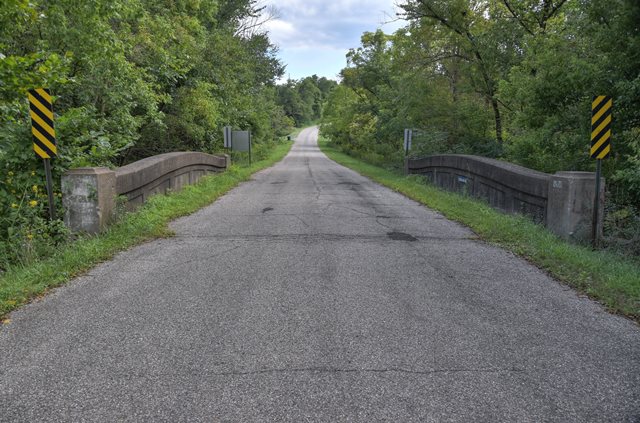We Recommend:
Bach Steel - Experts at historic truss bridge restoration.
BridgeHunter.com Phase 1 is released to the public! - Visit Now
Liberty Road Bridge

Primary Photographer(s): Nathan Holth
Bridge Documented: August 24, 2019
New Concord: Muskingum County, Ohio: United States
Not Available or Not Applicable
40.0 Feet (12.2 Meters)
45.0 Feet (13.7 Meters)
24 Feet (7.32 Meters)
1 Main Span(s)
6053203

View Information About HSR Ratings
Bridge Documentation
This is a rare surviving example of a curved chord through girder bridge in Ohio.
View Archived National Bridge Inventory Report - Has Additional Details and Evaluation
Information and Findings From Ohio's Historic Bridge InventorySetting/Context The bridge carries a 2 lane road over a stream in a sparsely developed, rural setting. Physical Description The 1 span, 45'-long, reinforced-concrete thru girder bridge has paneled, shaped girders with blocky end posts and articulated floorbeams. It is supported on concrete abutments. Summary of Significance The ca. 1928 thru girder bridge is a late and
undistinguished example of a standardized bridge type in use from the
mid 1910s to 1930s. It is not technologically significant.
Reinforced-concrete thru girder bridges are composed of a pair of
cast-in-place longitudinal girders and transverse floorbeams or deck
slab (the former is the case with most Ohio examples) that are connected
by the arrangement of the steel reinforcing bars. The roadway passes
between the paired girders, which are the main supporting members and
also serve as railings. The girders are commonly very large in
appearance (18" to 30" wide and 4' to 6' deep) and have deep panels to
save on weight. The depth of the girders is related to span length with
the longer the span the greater the depth. In many cases, the girders
are shaped to achieve the greatest depth of beam at mid-span where it is
required to support the design moments (stresses). The shaped girder is
a design detail to accommodate longer and/or wider spans and/or heavier
design loads, it is not aesthetic. Bridge Considered Historic By Survey: No |
![]()
Photo Galleries and Videos: Liberty Road Bridge
Bridge Photo-Documentation
Original / Full Size PhotosA collection of overview and detail photos. This gallery offers photos in the highest available resolution and file size in a touch-friendly popup viewer.
Alternatively, Browse Without Using Viewer
![]()
Bridge Photo-Documentation
Mobile Optimized PhotosA collection of overview and detail photos. This gallery features data-friendly, fast-loading photos in a touch-friendly popup viewer.
Alternatively, Browse Without Using Viewer
![]()
Maps and Links: Liberty Road Bridge
Coordinates (Latitude, Longitude):
Search For Additional Bridge Listings:
Bridgehunter.com: View listed bridges within 0.5 miles (0.8 kilometers) of this bridge.
Bridgehunter.com: View listed bridges within 10 miles (16 kilometers) of this bridge.
Additional Maps:
Google Streetview (If Available)
GeoHack (Additional Links and Coordinates)
Apple Maps (Via DuckDuckGo Search)
Apple Maps (Apple devices only)
Android: Open Location In Your Map or GPS App
Flickr Gallery (Find Nearby Photos)
Wikimedia Commons (Find Nearby Photos)
Directions Via Sygic For Android
Directions Via Sygic For iOS and Android Dolphin Browser
USGS National Map (United States Only)
Historical USGS Topo Maps (United States Only)
Historic Aerials (United States Only)
CalTopo Maps (United States Only)

